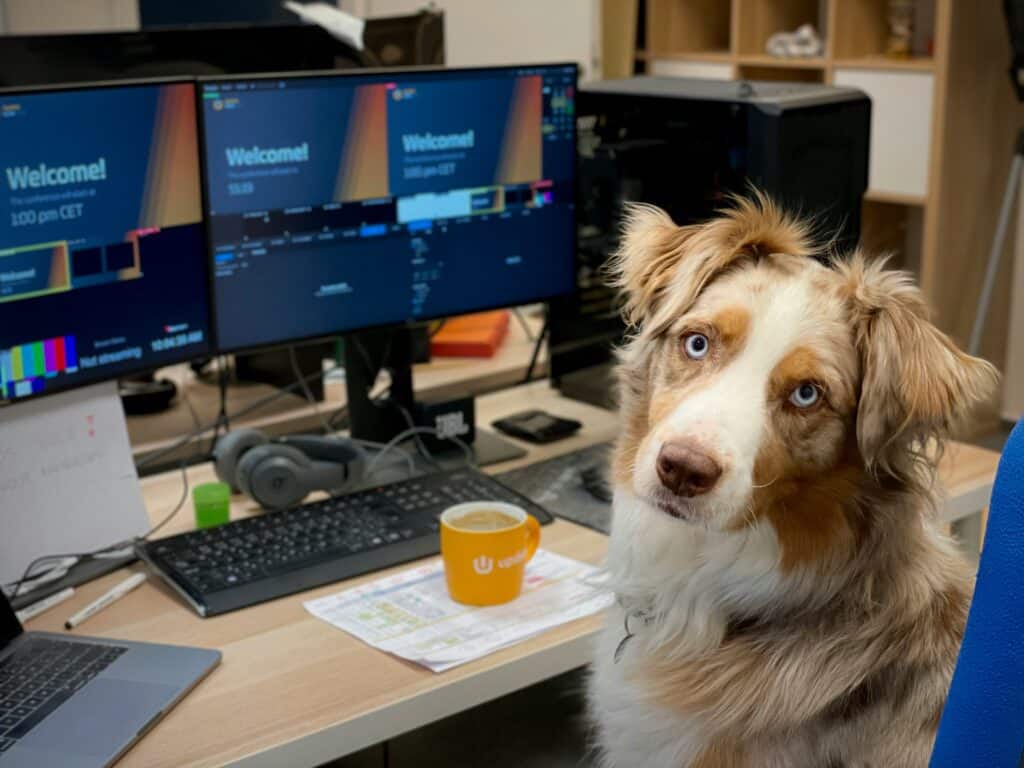We recently had an interesting enquiry regarding an employee bringing their pet dog to work: are there any health and safety concerns?
Research has shown that bringing pets, especially dogs, to work has many positive benefits.
It helps increase your team’s commitment, demonstrates your engagement to team wellbeing, and improves workplace communication, reducing isolation.
Despite the benefits of having pets in the office, health and safety issues still exist. Focusing on dogs specifically, as they’re the most likely to be a support animal, you should add their presence to your general risk assessments.
Bringing a large, excitable, slobbering, overly friendly dog into an office might cause safety issues.
You’ll need to confirm your office environment is pet-friendly. Do you have any hazards like cables or toxic plants? Do you need to keep a sterile or hygienic environment? Is anyone allergic to the animal?
You also can’t assume everyone in your office likes dogs. Some may have cynophobia, a fear of dogs, which you must consider.
However, if there are no objections from colleagues, you should prepare a code of practice.
We’ve put together a list of things to consider including in your code of practice and even make part of your risk assessment:
- Make it clear that the dog’s owner is legally and financially responsible for any damage it makes to people or property – they may have appropriate third-party insurance or consider getting cover.
- A probationary period – to make sure the dog is happy in the work environment and that their presence and behaviour are not unduly interrupting work.
- Set some ground rules about what constitutes acceptable behaviour, as not every dog is suited to office life – for example, no running around, constant barking, or drooling over the furniture.
- Ask for proof of up-to-date vaccinations – as well as regular treatment for ticks, fleas, and mites.
- Not allowing dogs in the office if they’re ill – as with humans, dogs need rest when sick, too.
- Make it crystal clear that the owner is responsible for the dog at all times and outline what should happen if the dog needs to be left for any time – for instance, when the owner is attending meetings or occasionally welfare visits.
- Agree on no-go areas – the kitchen is likely on everyone’s list, but also consider areas where someone afraid of dogs may likely frequent, like a reception area or a specific colleague’s desk.
- Make sure you have suitable feeding and toileting areas for the dog to avoid any clean-ups – the last thing anyone wants is a lingering smell in the office.
- Check to see how the dog reacts to fire alarms when they’re first in the office – if they’re panicky or reactive, it might be best to leave them at home.
- Don’t forget to include them in any personal emergency evacuation plans – it may just be the case of holding back for a few seconds at the refuge points so that colleagues don’t trip over the dog in stairwells or corridors.
- Any allergies team members may have to animals – dog-free zones can help depending on how severe the allergy is, so it’s best to discuss suitable accommodations with anyone affected before allowing dogs.
Once you’ve created your policy or code, ask the owner to bring the dog in for a meet-and-greet session. This allows your team to meet their potential new colleague and get to know each other better.
Use an area where everyone can ask questions, and you can set out the ‘house rules’ so everyone is on the same page.
Remember, like any new starter on their first day, the dog may be a little excited and overwhelmed. Ensure they have plenty of space to acclimate to their new surroundings.
If you’re considering implementing a dog-friendly policy in your workplace, talk to us about your plans. We’ll help you manage the risks and make sure you’re not barking up the wrong tree.






